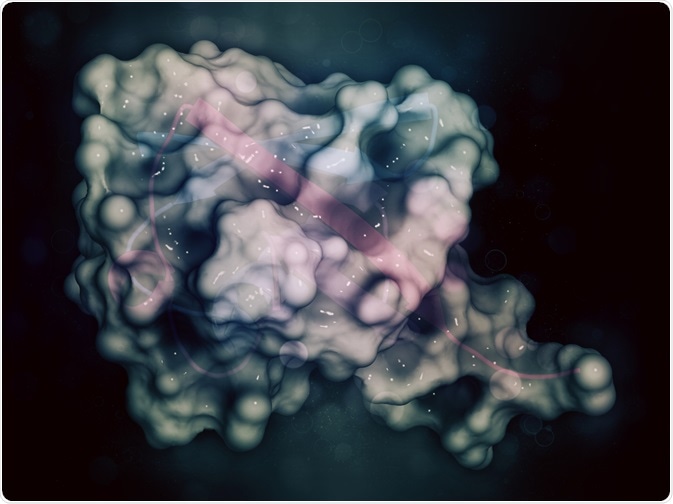Proteins are critical to an organism’s functioning. Once produced by the cell, a protein’s role can be tailored through modifications with the protein ubiquitin. Here, we take a closer look at what protein ubiquitylation exactly is and how it works.

Image Credit: StudioMolekuul/Shutterstock.com
What do we mean by protein ubiquitylation?
A small (8 kDa) protein called ubiquitin (Ub) plays a critical role in the running of eukaryotes. Provided that a protein has accessible amino groups (most commonly in the form of a lysine), it can be modified with Ub.
Through the help of enzymes, Ub latches onto proteins (known as ubiquitylation), controlling a variety of cellular signaling and degradation processes.
How does it work?
Protein ubiquitylation relies heavily on three groups of enzymes: Ub-activating, Ub-conjugation, and Ub-protein ligase — helpfully named E1, E2, and E3, respectively. Occurring in sequence, the primary goal of these enzymes is to work together to create an isopeptide bond, linking Ub to the target protein.
Typically, this bond forms between Ub’s terminal glycine residue and a lysine residue on the target protein.
First, Ub is activated using adenosine triphosphate (ATP) — the main cellular energy provider. For this step, E1 adds an ATP derivative (adenylate) to the C-terminus of Ub, which then allows E1 to link itself to Ub, replacing adenylate in the process. Next, E2 shuttles Ub from E1 to its active site, ready for transfer onto the target protein.
The final step requires E3 to recruit the target protein and transfer Ub from the E2 active site onto the target protein. Ub transfer can occur either directly, where Ub is directly moved onto the target protein; or indirectly, where E3 forms a covalent bond with Ub before being tagged onto the target protein.
This difference in approach by the E3 enzymes is due to the variety of types available – with over 600 different E3 enzymes found in humans – each creating different Ub linkages and structures. In comparison, there are only a couple of E1 enzymes and around 40 E2 enzymes.
What are these Ub tags used for?
Ub tags are found abundantly throughout the cell’s proteins, forming a key post-translational modification. Marking cells for a huge variety of signaling processes, Ub tags are involved in almost all processes including DNA repair, proteasomal degradation, immunity, trafficking, apoptosis, signal transduction, and development.
Lack of a working protein ubiquitylation system in humans can result in a variety of pathologies, such as degenerative diseases, cancer, and diabetes.
How can Ub be a marker for so many different processes?
These Ub tags come in a range of shapes and sizes, owed in part to the range of ubiquitylating enzymes available to create different ubiquitin structures, while also due to proteins having multiple and exposed amino groups. This variety in Ub tags can be seen by exploring the different types of protein ubiquitylation.
Target proteins may be modified with a single Ub, known as monoubiquitination, or several single Ub molecules, creating proteins that are multi-monoubiquitylated. Also, Ub itself has seven lysines, all of which can be ubiquitylated.
This creates a Ub chain that can be tagged onto a target protein, resulting in polyubiquitylated proteins.
Not only are these differences in Ub chain structures controlled by E3 enzymes, which are responsible for creating different Ub linkages in the chains and on the target protein, but E2 also has emerged as controlling Ub tag diversity. E2 enzymes can determine whether to start a new or continue the Ub chain, affecting the overall shape of the Ub protein tag.
Ub tags are recognized by proteins that contain Ub-binding domains, known as Ub-binding proteins (UBDs). These UBDs only recognize specific Ub structures, resulting in proteins being marked for different processes depending on their Ub tag form.
With single or shorter Ub chains used in signaling processes, DNA repair, and endocytosis, longer chains stimulate proteasomal degradation with knock-on effects to signaling, immunity, and development.
Further to this, a final group of enzymes exists in regulating protein ubiquitylation. This group of enzymes removes Ub from target proteins or Ub chains, known as the deubiquitylating enzymes.
Removal of Ub from the target protein can leave Ub tags that can signal for a different process, such as gene expression and apoptosis, while also replenishing the amounts of Ub available for use in protein ubiquitylation elsewhere in the cell.
Conclusion
Ubiquitylation is a key process in controlling protein function, where the number, shape, and length of a protein’s Ub tag can greatly affect the future role of a protein in the body. This sequential and enzyme-regulated system is needed for cells to work properly, where a faulty ubiquitylation system can lead to an array of diseases.
References
- Gupta, I. et al. (2018) ‘Delineating crosstalk mechanisms of the ubiquitin-proteasome system that regulate apoptosis’, Frontiers in Cell and Developmental Biology. Frontiers, 6, pp. 11.
- Kliza, K. and Husnjak, K. (2020) ‘Resolving the Complexity of Ubiquitin Networks’, Frontiers in Molecular Biosciences, 7, pp. 21.
- Sadowski, M. et al. (2012) ‘Protein monoubiquitination and polyubiquitination generate structural diversity to control distinct biological processes’, International Union of Biochemistry and Molecular Biology (IUBMB) Life, 64(2), pp. 136–142.
- Stewart, M. D. et al. (2016) ‘E2 enzymes: More than just middlemen’, Cell Research, 26(4), pp. 423–440.
- Ye, Y. and Rape, M. (2009) ‘Building ubiquitin chains: E2 enzymes at work’, Nature Reviews Molecular Cell Biology, 10(11), pp. 755–764.
Further Reading